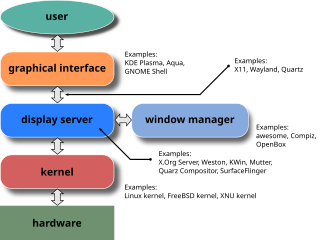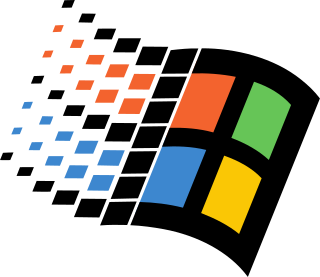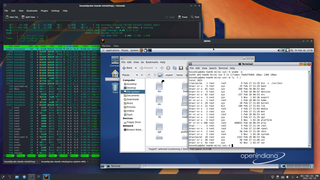
AIX is a series of proprietary Unix operating systems developed and sold by IBM for several of its computer platforms.

Mandriva Linux is a discontinued Linux distribution developed by Mandriva S.A.

The X Window System is a windowing system for bitmap displays, common on Unix-like operating systems.

An X window manager is a window manager that runs on top of the X Window System, a windowing system mainly used on Unix-like systems.

Windows 9x is a generic term referring to a series of Microsoft Windows computer operating systems produced from 1995 to 2000, which were based on the Windows 95 kernel and its underlying foundation of MS-DOS, both of which were updated in subsequent versions. The first version in the 9x series was Windows 95, which was succeeded by Windows 98 and then Windows Me, which was the third and last version of Windows on the 9x line, until the series was superseded by Windows XP.

The F Virtual Window Manager (FVWM) is a virtual window manager for the X Window System. Originally a twm derivative, FVWM has evolved into a powerful and highly configurable environment for Unix-like systems.

A window manager is system software that controls the placement and appearance of windows within a windowing system in a graphical user interface. Most window managers are designed to help provide a desktop environment. They work in conjunction with the underlying graphical system that provides required functionality—support for graphics hardware, pointing devices, and a keyboard—and are often written and created using a widget toolkit.

Xinerama is an extension to the X Window System that enables X applications and window managers to use two or more physical displays as one large virtual display.

QEMU is a free and open-source emulator. It emulates a computer's processor through dynamic binary translation and provides a set of different hardware and device models for the machine, enabling it to run a variety of guest operating systems. It can interoperate with Kernel-based Virtual Machine (KVM) to run virtual machines at near-native speed. QEMU can also do emulation for user-level processes, allowing applications compiled for one architecture to run on another.

The Sun Ray was a stateless thin client computer aimed at corporate environments, originally introduced by Sun Microsystems in September 1999 and discontinued by Oracle Corporation in 2014. It featured a smart card reader and several models featured an integrated flat panel display.

In computing, a virtual desktop is a term used with respect to user interfaces, usually within the WIMP paradigm, to describe ways in which the virtual space of a computer's desktop environment is expanded beyond the physical limits of the screen's display area through the use of software. This compensates limits of the desktop area and is helpful in reducing clutter of running graphical applications.
A viewport is a polygon viewing region in computer graphics.
The Windows shell is the graphical user interface for the Microsoft Windows operating system. Its readily identifiable elements consist of the desktop, the taskbar, the Start menu, the task switcher and the AutoPlay feature. On some versions of Windows, it also includes Flip 3D and the charms. In Windows 10, the Windows Shell Experience Host interface drives visuals like the Start Menu, Action Center, Taskbar, and Task View/Timeline. However, the Windows shell also implements a shell namespace that enables computer programs running on Windows to access the computer's resources via the hierarchy of shell objects. "Desktop" is the top object of the hierarchy; below it there are a number of files and folders stored on the disk, as well as a number of special folders whose contents are either virtual or dynamically created. Recycle Bin, Libraries, Control Panel, This PC and Network are examples of such shell objects.

olwm was the default stacking window manager for OpenWindows, the original X11 desktop environment included with SunOS and Solaris. Its unique characteristic is its implementation of the OPEN LOOK look and feel.

Oracle VM VirtualBox is a type-2 hypervisor for x86 virtualization developed by Oracle Corporation. VirtualBox was originally created by InnoTek Systemberatung GmbH, which was acquired by Sun Microsystems in 2008, which was in turn acquired by Oracle in 2010.

Wubi is a free software Ubuntu installer, that was the official Windows-based software, from 2008 until 2013, to install Ubuntu from within Windows, to a single file within an existing Windows partition.

DeskSpace, formerly known as Yod'm 3D is a virtual desktop manager available for Windows XP, Vista, 7 and 8.
Extended Window Manager Hints, a.k.a. NetWM, is an X Window System standard for the communication between window managers and applications. It builds on the functionality of the Inter-Client Communication Conventions Manual (ICCCM).

Qubes OS is a security-focused desktop operating system that aims to provide security through isolation. Isolation is provided through the use of virtualization technology. This allows the segmentation of applications into secure virtual machines called qubes. Virtualization services in Qubes OS are provided by the Xen hypervisor.

Blisk is a freemium Chromium-based web browser that aims to improve productivity and code quality by providing a wide array of tools for Web development and testing for different type of devices: desktop, tablet and mobile.














